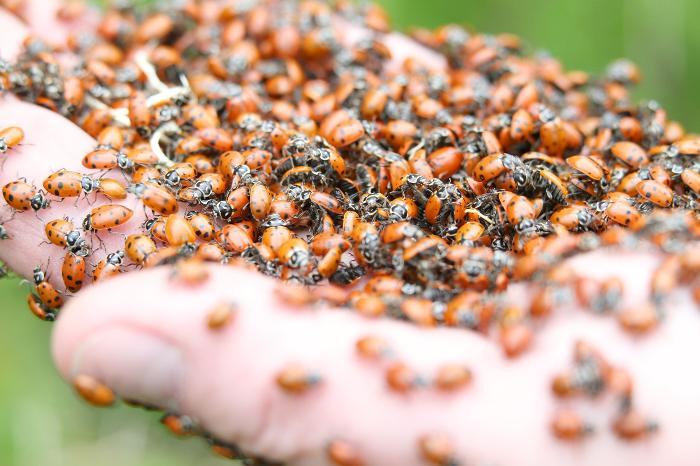On a recent weekday afternoon, Tom Heisinger plopped a small wooden crate near a patch of spirea outside Golub House. Using a small knife, he slices open the protective cheesecloth-like material stuffed inside the crate.
In a scene lifted a from B-list horror movie, tens of thousands of ladybugs rush from the crate, anxious to escape the tight quarters they've been packed in for the two-day cross-country journey from Arizona.
Dozens attach themselves to Heisinger, covering his face, neck, arms and the legs of his work jeans. Undeterred, he digs into the crate with his hand and scoops out gobs more insects, tossing them into the air like grass seed.
It's time for the ladybugs to get to work.
The ladybugs are part of Heisinger's lethal arsenal of insects that feast on destructive pests such as aphids and other herbivorous pests, dramatically reducing the need for pesticides and insecticides across campus. The manager of Grounds, Heisinger also deploys praying mantises and green lacewing to protect the lush holly, barberry and euonymus plants that decorate the College landscape.
By eliminating or containing the pests, the bugs play a crucial role in maintaining the elegant beauty for which Union is known.
"They clean 'em up quick," Heisinger said of the ladybugs, which devour aphids, soft, pear-shaped insects that inflict major damage by sucking sap from plants. "There've been times when you can see the aphids on the branches and leaves of the plants, and I'll put the ladybugs out. You come back in a week, and the aphids are gone."
The use of beneficial insects around the College's 120 acres is part of an Integrated Pest Management strategy. IPM focuses on protecting the natural resource base and limits degradation of soil and water quality by severely restricting the use of chemical pesticides and insecticides. This is desirable because pesticides and insecticides contribute to climate change, are persistent and get concentrated in the food chain.
"The release of these insects strengthens our connection with the natural environment while making the campus a healthier place for all," said Meghan Haley-Quigley ’11, Union's sustainability coordinator.
Heisinger figures he's been unleashing waves of ladybugs and praying mantises at Union for at least a dozen years. He usually goes out two or three times in late spring, when the plants are in full bloom. This year, thanks to a $2,000 Presidential Green Grant he was awarded in November, he's been able to buy more bugs.
"Getting that grant was a godsend," he said.
On this recent afternoon, Heisinger planned to release two gallons of ladybugs. Each gallon contains 70,000 insects, so 140,000 ladybugs instantly joined the campus community.
"But there's no guarantee they will stick around," Heisinger said. "If there's no food source, they will move on."
While the release of the ladybugs is colorful and dramatic, the introduction of praying mantises is, well, a little more serene. First, they arrive as egg sacs, with each sac containing 200 insects that won't hatch for a few weeks. And instead of tossing and shaking them into the air, Heisinger methodically places the egg sacs in targeted spots, such as in the crack of a crabapple tree, to shield them from hungry ants on the ground. When the eggs hatch, the insects blend into the background, making them difficult to notice.
"I saw one near the Nott last year," he said. "That was the first one I had seen in years."
And unlike ladybugs, which prefer to dine on aphids, praying mantises don't possess a fussy palate.
"They will take care of just about anything they can capture and devour," said Heisinger. "They will even eat the ladybugs if they can. You just hope that doesn't happen."
